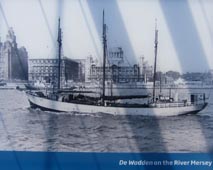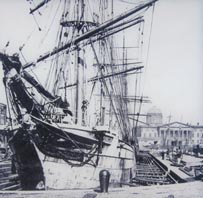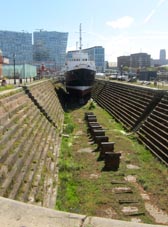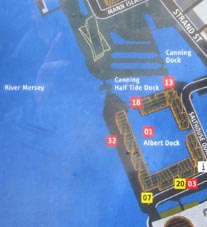|
英国リバプールの「キャニング・ドック」 (Canning Dock) の中に設けられた「キャニング・グレービング・ドックス*」
(Canning Graving Docks キャニング船舶修理ドック) に泊渠・展示されるパイロット船「エドムンド・ガードナー号 (Edmund Gardner)」、
およびばら積み運搬船「デ・ワデン号 (De Wadden)」。
現在政府予算の縮減のため、キャニング・キーサイズ・エリア (Canning Keysides Area・キャニング船舶修理ドックの埠頭地区) を
開発し、これらの係留船へのフル・アクセスを可能にするための公共事業計画はキャンセルされている。
画像(上)の「デ・ワデン号」(1917年)は、1922年~1961年の間、石炭、木材、石、穀物などをリバプールとアイルランド諸港の間を
輸送する交易船であった。1917年にオランダの Gebr van Diepen of Waterhuizen によって建造されたもので、リバプール市内を流れる
マージー川で、帆力をもって運送業務に就いた最後の船である。帆とエンジンをもつ機帆船であったが、帆力を利用したのは
モーターが何か特別な補助を必要とした時だけであった。デ・ワデン号は、リバープールとアイルランド間の長い交易史の象徴である。
案内パネルには次のように記されている。
De Wadden, 1917
De Wadden was a trading ship that carried coal, timber, stone and grain between Liverpool and ports in Ireland
between 1922 and 1961. She wasthe last ship working on the Mersey to use sails and was built in 1917 by Gebr
van Diepen of Waterhuizen in the Netherlands.
De Wadden was built with sails and an engine, but only used sail power when the motor needed
extra help. She is a symbol of the long history of trade between Liverpool and Ireland.
下の画像のNo.2は「エドムンド・ガードナー号」という、リバプールの水先案内船No.2である。
ダートマス (Dartmouth) にて、Philip & Sons Ltd. 会社によって、1953年に建造された。
リバプール港に入ってくる船と合流するため、パイロット (水先案内人) をその沖まで輸送した。
パイロットはマージー川のことを熟知する船乗りで、彼らはリバプール港へ船を入港させるために、サンドバンンク (sandbank;
砂洲・砂堆(さたい)) の障害を安全に導いた。案内パネルには次のように記されている。
Edmund Gardner, Liverpool Pilot Cutter No.2, 1953.
Built in 1953 by Philip & Sons Ltd. of Dartmouth, Edmund Gardner carried
pilots out to sea to meet ships coming to Liverpool. Pilots are seafarers with local knowledge of the River Mersey.
They guide ships safely through the sandbanks that line the approach to Liverpool.
[2013.6.1 英国リバプール・マージーサイド海洋博物館にて][拡大画像: x25216.jpg][拡大画像: x25220.jpg: 説明書き(英文)]
1 2 2
1. 「De Wadden号」の写真。 [拡大画像: x25217.jpg][拡大画像: x25218.jpg:説明書き(英文)]
2. 「Edmund Gardner号」の写真(リバプールのPier Head前にて)。 [拡大画像: x25219.jpg][拡大画像: x25220.jpg:説明書き(英文)]
3 4 4
3. 1890年頃の「キャニング・グレービング・ドックス」 (Canning Graving Docks)。
[拡大画像: x25221.jpg][拡大画像: x25222.jpg: 説明書き「Canning Graving Docks*, 1765」 (その英文内容は下記の
通り**)]
4. 階段状に石のブロックを積み上げて造られたドライ・ドック (キャニング・グレービング・ドックスの一つ) に、
「エドムンド・ガードナー号」が泊渠している。 [拡大画像: x25223.jpg]
[参考]
* grave:
vt.(graved, graving)[海][船底]の付着物を落して(取り除いて)、タールやピッチなどを塗る・塗料などを施す、船底を清掃・掃除する.
/graving dock: n.[海]グレービング・ドック[船底に掃除・修理用の乾ドック、ドライドック]、[広義に]乾ドック (dry dock)
/graving expenses: 船底清掃費.
** Canning Graving Docks, 1765
Graving docks are where ships are maintained and repaired.
Shipwrights scraped off barnacles - marine animals in shells which attach themselves to
the bottom of ships. This was called graving, which is why these docks are known as graving docks.
Once a ship was in the dock, the gates were shut and the water pumped out or drained through pipes or small gates.
The ship was left high and dry, sat on blocks and propped up at the sides with wooden beams.
Canning Graving Docks were opened in1765, making them the oldest part of the Liverpool docks still in use.
They would have been used to repair different types of vessels, including slave ships.
The docks are only big enough for ships of a certain size. As ships got longer, wider and deeper, they were unable to use
the Canning Graving Docks.

ドック周辺概略図。図の上方のドックがキャニング・ドック、下方のそれがアルバート・ドック。両ドックの間にあるNo.18がマージー
サイド海洋博物館である。 [拡大画像: x25212.jpg]
辞典内関連サイト
・ 世界の海洋博物館
・ 英国の海洋博物館
|  Back to: Top Page |
Back to: Top Page |  Back to: Top Page |
Back to: Top Page |  Back to: Top Page |
Back to: Top Page |  Back to: Top Page |
Back to: Top Page |